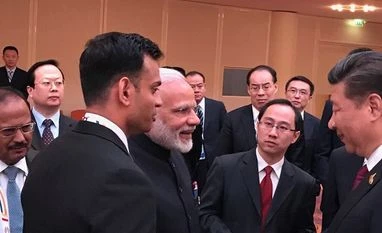As India’s Himalayan border standoff with China enters its third month, one thing has become glaringly obvious: Beijing has no intention of treating New Delhi as an equal. Belligerent official statements and bellicose articles in Chinese state-run media suggest that, in “Game of Thrones” parlance, President Xi Jinping expects Prime Minister Narendra Modi to “bend the knee.”
The standoff dates to June when Indian troops entered a plateau claimed by both China and the tiny Himalayan kingdom of Bhutan to block the Chinese from upgrading and extending a rudimentary road. From India’s perspective, China’s road building on disputed territory looks a lot like its construction of islands in the South China Sea—an attempt to create military advantage by building infrastructure.
Indian analysts fear that the roadwork would make it easier for China to cut off the so-called chicken’s neck, a narrow strip of land that links northeastern India to the rest of the country. Since India has a close treaty relationship with Bhutan, Indian officials play down the unusual step of intervening in a territorial dispute where technically India isn’t a disputant.
China’s position hinges on a confusingly worded 1890 treaty between the Qing dynasty and British India. According to Beijing’s interpretation of that treaty, the disputed Doklam plateau falls firmly in Chinese territory. (Bhutan and India read it differently.) Moreover, as the Chinese argument goes, India has no business intervening in the matter since it lays no claim to the territory in question.
While Indian and Chinese troops face off in the disputed area, the tenor of Beijing’s response ought to give Indians pause. Instead of taking Indian and Bhutanese concerns on board as a valid subject of discussion, China has adopted a stance that oscillates between belligerence and dismissiveness. It suggests a deeper truth that will endure regardless of how the current crisis is resolved. Bluntly put, a powerful China shows no intention of granting India the peer status that it craves.
In Bangkok last month, Chinese Foreign Minister Wang Yi underscored this dismissiveness. “The solution to this issue is simple, which is that the Indian troops back out honestly,” he said. China’s ambassador in New Delhi made similar demands for Indian troops to “unconditionally pull back.” A Chinese defense ministry spokesperson warned India that “it’s easier to shake a mountain than the PLA,” or the People’s Liberation Army.
Meanwhile, Chinese state-owned media outlets have taken to saber rattling. An editorial in China Daily blamed “India’s audacity in challenging China’s sovereignty” on a “sense of inferiority and insecurity in the face of China’s rapid rise.” Xinhua warned India to “dispel all illusions and avoid disastrous consequences.” The reliably hyperventilating Global Times accused India’s “naïve” government of not heeding the lessons of China’s 1962 victory in a brief border war. “This time we must teach New Delhi a bitter lesson,” said an editorial.
Beyond the immediacy of the Doklam standoff, China’s pugnaciousness reflects a deeper truth that many Indians have been slow to grasp. The West tends to view India in largely sympathetic terms—as a democratic country that has made large strides over the course of 70 years since independence from Britain.
The Chinese, on the other hand, see a chaotic and poverty-ridden upstart, proof that democracy doesn’t work in developing countries. In a 2013 essay for the World Policy Journal, Chinese journalist Li Xin recounted advice Chinese travel agents give tourists headed to India: “Don’t ask strangers to take photos for you, or your cameras could disappear,” and “don’t give money to pan-handlers, or they will ask for more.”
At one level, Chinese disdain is understandable. Economic growth has powered China’s rise to the head table of global affairs, and by that yardstick India is simply not comparable.
In 1970, India’s economy was slightly larger than China’s. Today the World Bank estimates that China’s $9.5 trillion economy is nearly four times larger than India’s.
In terms of per capita income, the two countries were neck-and-neck as recently as 1983. Now, with a per capita income of about $6,900, the average Chinese earns more than three and a half times more than the average Indian.
These economic disparities show in other ways too. Over the past three decades, Beijing and Shanghai have emerged as cities famous for their modern architecture and world-class infrastructure. India’s shambolic cities compete with their Chinese counterparts on only one parameter: Pollution. Delhi has overtaken Beijing as the world’s most polluted capital city.
Or take sports, where China has transformed itself from a straggler to an Olympic powerhouse. In India, they make movies about athletes who win medals in the largely invisible Commonwealth Games.
The Chinese view of India may be unkind, and almost certainly undervalues traditional Indian strengths such as a relatively free media, an independent judiciary and a historically successful record of managing vast diversity. But it would be unreasonable to expect China to value in its southern neighbor those qualities it lacks itself.
For India, the deeper lesson of the Doklam crisis ought to be clear. A Western-led order in Asia may not be perfect, but a Chinese-led order will diminish, not enhance, the standing that India seeks.
Mr. Dhume is a resident fellow at the American Enterprise Institute, and a columnist for WSJ.com.
Unlock 30+ premium stories daily hand-picked by our editors, across devices on browser and app.
Pick your 5 favourite companies, get a daily email with all news updates on them.
Full access to our intuitive epaper - clip, save, share articles from any device; newspaper archives from 2006.
Preferential invites to Business Standard events.
Curated newsletters on markets, personal finance, policy & politics, start-ups, technology, and more.
)